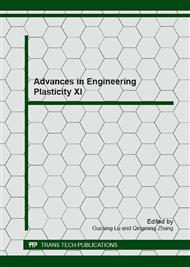p.168
p.173
p.177
p.181
p.185
p.189
p.193
p.197
p.201
Evaluation of Deformation Behavior of Silica-Filled Rubber under Monotonic and Cyclic Straining
Abstract:
To clarify the essential deformation characteristics of silica-filled rubber, we construct the finite element homogenization models of silica-filled rubber with newly proposed nonaffine molecular chain network model of rubber. These models can reflect the generation of complicated inter-fillers connecting phases where the characteristics of rubber are intricately changed depending on the volume fraction of silica coupling agent and relative size of particles and their location. The results obtained clarified the essential physical enhancement mechanisms of deformation resistance and hysteresis loss for rubber filled with silica with different distribution patterns under diffrent rate of deformation. The volume fraction of coupling agent essentially affects the deformation behavior of silica filled rubber which suggests the high controlability of the material characteristics of silica filled rubber as compared with carbon black filled rubber.
Info:
Periodical:
Pages:
185-188
Citation:
Online since:
January 2013
Authors:
Price:
Сopyright:
© 2013 Trans Tech Publications Ltd. All Rights Reserved
Share:
Citation:


